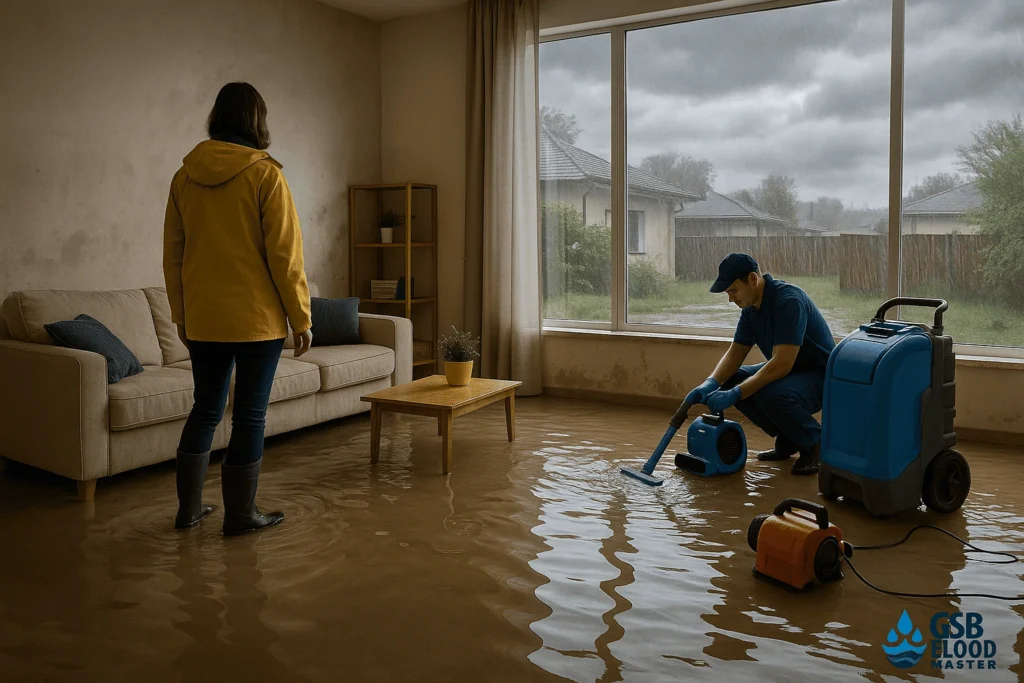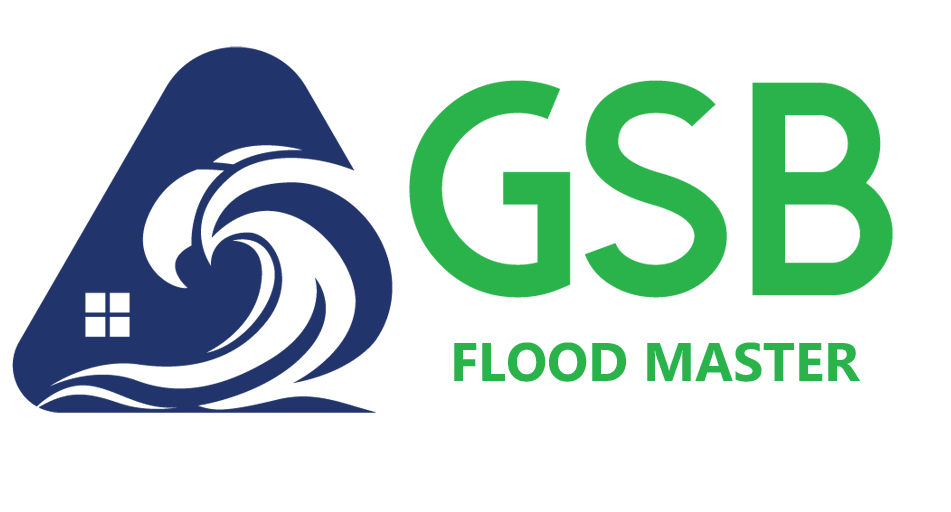When Perth’s unpredictable weather strikes and leaves your home waterlogged, the first few hours are crucial. Whether it’s a sudden downpour that’s overwhelmed your gutters or a severe storm that’s damaged your roof, knowing exactly what to do can mean the difference between minor repairs and major renovations.
As Perth’s weather patterns become increasingly volatile, more homeowners are finding themselves dealing with unexpected water damage. The good news is that with the right immediate response and proper insurance claims process, you can minimize damage and get your home back to normal quickly.
Immediate Steps When Storm Water Damages Your Home

The moment you discover water damage in your Perth home, time becomes your most valuable asset. Here’s your emergency action plan:
Step 1: Ensure Safety First
Before assessing damage, check that your home is safe to enter. Look for:
- Electrical hazards from wet outlets or exposed wiring
- Structural damage to walls, ceilings, or floors
- Slippery surfaces that could cause falls
- Potential contamination if sewage systems have backed up
Never enter standing water if there’s any chance of electrical hazards. If you’re unsure about safety, contact emergency services immediately.
Step 2: Stop the Water Source
If the water is coming from inside your home (burst pipes, leaking appliances), locate and turn off the main water supply. For external flooding from storms, focus on preventing additional water entry by:
- Covering damaged roof areas with tarps
- Blocking gaps around windows and doors
- Moving belongings away from actively leaking areas
- Placing buckets or containers to catch dripping water
Step 3: Document Everything Immediately
Before touching anything, grab your phone and start documenting. Take photos and videos of:
- All damaged areas from multiple angles
- Water levels and extent of flooding
- Damaged belongings and furniture
- Any structural damage to walls, floors, or ceilings
- The source of water entry if visible
This documentation will be crucial for your insurance claim and helps professional assessors understand the full extent of damage.
Step 4: Begin Water Removal
Once safety is confirmed and documentation is complete, start removing water as quickly as possible. Use whatever tools you have available:
- Mops and buckets for small amounts
- Wet/dry vacuums for moderate water
- Pumps for significant flooding
- Towels and rags for surface water
The faster you remove standing water, the less damage you’ll have to carpets, flooring, and structural elements.
Step 5: Contact Professional Help
While you’re handling immediate concerns, call for professional assistance. Storm-related water damage often requires specialized equipment and expertise that goes beyond basic cleanup. Professional cleanup services in Perth can assess hidden damage, prevent mold growth, and ensure complete drying that’s not visible to the untrained eye.
Understanding Your Insurance Coverage
Perth homeowners often discover too late that their insurance policies don’t cover all types of water damage. Understanding your coverage before disaster strikes can save you thousands of dollars and significant stress.
What’s Typically Covered
Most Perth home insurance policies cover water damage from:
- Sudden burst pipes or plumbing failures
- Storm damage to roofs causing internal flooding
- Appliance leaks (washing machines, dishwashers, water heaters)
- Accidental overflow from baths, sinks, or toilets
What’s Usually Not Covered
Standard policies often exclude:
- Gradual leaks or seepage
- Flood damage from external sources
- Damage due to poor maintenance
- Sewer backup (unless specifically added)
- Damage from burst pipes due to freezing
Reading Your Policy
Before you need to make a claim, review your policy documents and understand:
- Your excess amount
- Coverage limits for water damage
- Specific exclusions
- Requirements for emergency mitigation
- Time limits for reporting claims
Step-by-Step Insurance Claim Process
Filing a successful insurance claim for storm water damage requires systematic approach and attention to detail.
Step 1: Contact Your Insurer Immediately
Most Perth insurance companies require notification within 24-48 hours of discovering damage. When you call:
- Have your policy number ready
- Provide basic details about the damage
- Ask about emergency mitigation coverage
- Request a claim number for reference
- Ask about recommended assessors or contractors
Step 2: Temporary Repairs and Mitigation
Your insurer will likely cover reasonable costs for temporary repairs to prevent further damage. This includes:
- Tarping damaged roofs
- Boarding up broken windows
- Water extraction and initial drying
- Temporary accommodation if your home is uninhabitable
Keep all receipts for these emergency measures, as they’re typically reimbursable.
Step 3: Professional Assessment
Your insurance company will arrange for a professional assessor to evaluate the damage. This is where having an experienced insurance assessment report becomes crucial for ensuring you receive fair compensation for all damage, including items that might not be immediately visible.
Step 4: Detailed Documentation
Supplement your initial photos with:
- Detailed inventory of damaged items
- Receipts or proof of purchase where possible
- Contractor quotes for repairs
- Records of any temporary accommodation costs
- Communication logs with your insurer
Step 5: Review Settlement Offers
Insurance companies may initially offer settlements based on minimum repairs. Don’t accept the first offer without:
- Getting independent repair quotes
- Ensuring all damage is identified
- Confirming replacement costs are current
- Understanding depreciation calculations
Common Storm Damage Scenarios in Perth
Perth’s unique climate creates specific water damage patterns that homeowners should recognize:
Roof Damage from Wind and Hail
High winds can lift roof tiles or damage guttering, creating entry points for water. Even small gaps can allow significant water infiltration during heavy rain.
Guttering Overflow
Perth’s intense rainfall can overwhelm guttering systems, particularly if they’re blocked by debris. This often causes water to back up under roof edges and into wall cavities.
Window and Door Seal Failures
Older Perth homes may have deteriorated seals around windows and doors. Storm-driven rain can penetrate these weak points, causing internal flooding.
Plumbing System Overload
During severe storms, Perth’s aging infrastructure can struggle with increased water flow, sometimes causing backups that affect individual properties.
Working with Professional Restoration Services
While initial cleanup might seem manageable, professional restoration services offer expertise that’s crucial for preventing long-term problems.
Hidden Damage Detection
Professional equipment can detect moisture in areas you can’t see or reach, including:
- Inside wall cavities
- Under flooring
- Within insulation
- Behind cabinets and fixtures
Mold Prevention
Perth’s humidity levels can promote rapid mold growth after water damage. Professional services use specialized drying equipment and antimicrobial treatments to prevent mold development.
Structural Integrity Assessment
Water damage can compromise structural elements in ways that aren’t immediately obvious. Professional assessors can identify potential safety issues and necessary repairs.
Insurance Liaison
Experienced restoration companies understand insurance requirements and can help ensure your claim covers all necessary work. They can also work directly with assessors to streamline the process.
Timeline for Recovery
Understanding realistic timeframes helps set expectations and plan accordingly:
Week 1: Emergency Response
- Immediate safety measures
- Water extraction and initial drying
- Insurance claim lodgement
- Temporary accommodation arrangements
Week 2-3: Assessment and Planning
- Professional damage assessment
- Insurance adjuster visits
- Contractor selection
- Detailed repair planning
Week 4-8: Restoration Work
- Structural repairs
- Flooring replacement
- Painting and finishing
- Final inspections
Beyond 8 Weeks: Complex Cases
- Extensive structural damage
- Mold remediation requirements
- Insurance disputes
- Building permit requirements
Preventing Future Storm Damage
While you can’t control Perth’s weather, you can take steps to minimize vulnerability:
Regular Maintenance
- Clean gutters and downpipes regularly
- Check roof tiles and flashing annually
- Inspect window and door seals
- Service plumbing systems regularly
Upgrade Considerations
- Install gutter guards
- Upgrade to impact-resistant roofing
- Improve drainage around your property
- Consider backup sump pumps
Emergency Preparedness
- Keep emergency supplies readily available
- Know your water shut-off locations
- Maintain current insurance coverage
- Have professional contacts ready
When to Call the Experts
While small spills or damp patches might seem manageable, some water damage scenarios are simply too risky — or too severe — to handle on your own. Knowing when to bring in professionals like GSB Flood Master can save your property from long-term damage and even protect your health.
You should always call a certified water damage restoration team when:
The affected area is larger than 10 square meters — That’s a strong indicator of widespread saturation, especially if walls or flooring are involved.
There’s standing water deeper than 5 centimeters — This increases the risk of structural issues and mould growth within hours.
Water has been sitting for more than 24 hours — The longer water lingers, the higher the chance of contamination and permanent damage.
You suspect any kind of structural compromise — Cracks, sagging ceilings, warped floors, or foul odours should never be ignored.
The water is contaminated — If it comes from sewage, storm runoff, or any source marked as “Category 3” (black water), don’t risk exposure.
At GSB Flood Master, our Perth-based IICRC-certified team is available 24/7 to respond to all levels of water and flood emergencies. From rapid water extraction to full structural drying and sanitation, we handle the hard work — so you can focus on getting life back to normal.
